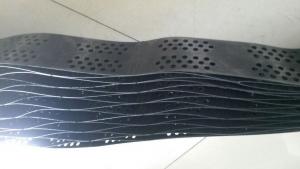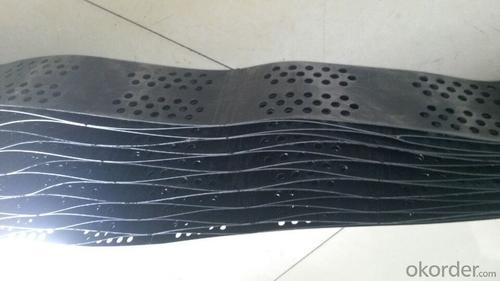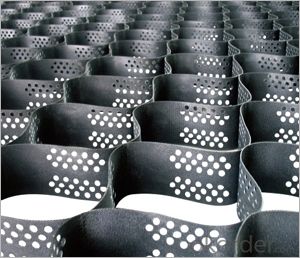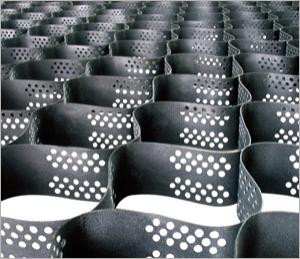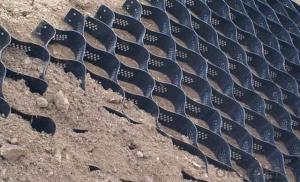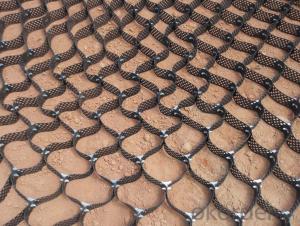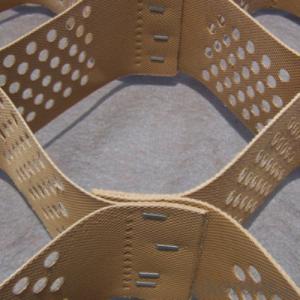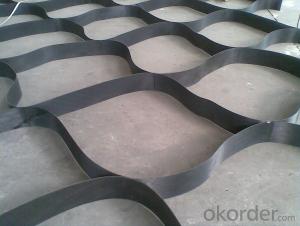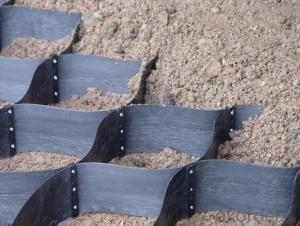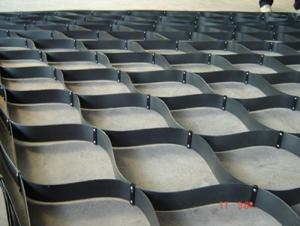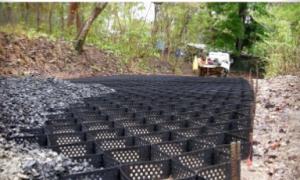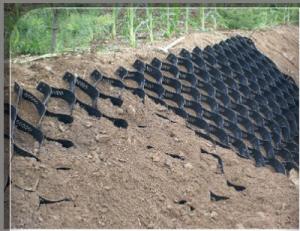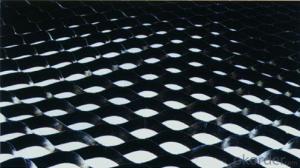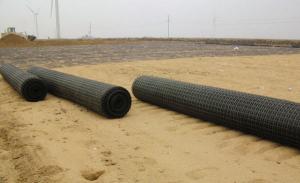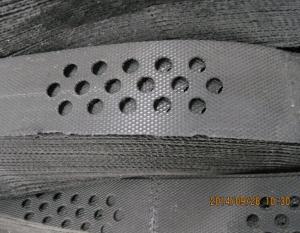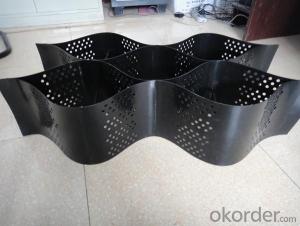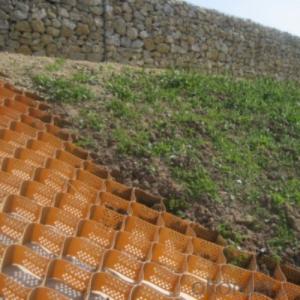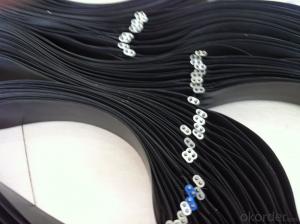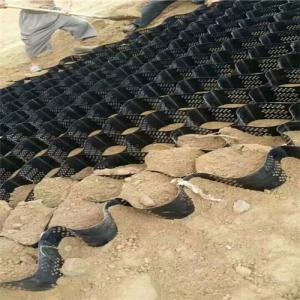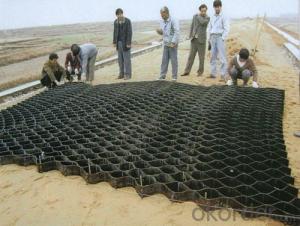Geocells Market HDPE Smooth Geocell Grass Paver with Vigrin Material and Good Price
- Loading Port:
- Qingdao
- Payment Terms:
- TT or L/C
- Min Order Qty:
- 5000 m²
- Supply Capability:
- 200000 m²/month
OKorder Service Pledge
OKorder Financial Service
You Might Also Like
Specification of Best Price HDPE Smooth Geocell Grass Paver
Polymer Density | High Density Polyethylene with density of 0.935 - 0.965 g/cm3 ASTM D 1505 |
Environmental Stress Crack Resistance | > 4000 hours ASTM D 1693 |
Carbon Black Content | Carbon black content 1.5% - 2.0% ASTM D 1603 |
Sheet Thickness | Smooth:1.1mm,1.2mm,textured:1.5mm ,1.7mm ASTM D 5199 |
Cell Details | welding distance:330-1000mm |
Cell Depth | 50-250mm |
Seam Peel Strength | As per US Army Corps of Engineer's Report GL-86-19 Appendix A |
Seam Hang Strength | A 100mm wide seam sample supports a 72.5 kg load for a minimum of 30 days in an ambient room temperature environment. |
Certification | CE ,ISO |
Classification | 1. smooth surface without hole 2. smooth surface with hole 3. textured surface with hole 4. textured surface without hole |
Applying Area of Best Price HDPE Smooth Geocell Grass Paver
1.Be used for firm the roadbed of railroad;2.Be used for firm highway soft foundation handling;
3.Be used for dike and retaining wall, which can bear load force;
4.Be used to harness the shoal water runway;
5.As pipeline and the sewer's propping up structure;
6.Be used for mixed type retaining wall that prevent the slope from falling down and bear load force;
7.Be used for independent wall, dock and breakwater;
8.Be used to harness the desert, beach and riverbed ,river bank
HDPE Geocell Technical Data Best Price HDPE Smooth Geocell Grass Paver
Height (mm) | Welding distance (mm) | Sheet thickness(mm) | Tensile yield strength of the cell≥(MPa) | Seam peel strength≥(N) | ||
smooth | textured | |||||
GS50-400 | 50 | 400 | 1-1.1 | 1.4-1.5 | 20 | 500 |
GS100-400 | 100 | 400 | 1-1.1 | 1.4-1.5 | 20 | 1000 |
GS150-400 | 150 | 400 | 1-1.1 | 1.4-1.5 | 20 | 1500 |
GS200-400 | 200 | 400 | 1-1.1 | 1.4-1.5 | 20 | 2000 |
GS75-330 | 75 | 400 | 1-1.1 | 1.4-1.5 | 20 | 750 |
GS100-330 | 100 | 400 | 1-1.1 | 1.4-1.5 | 20 | 1000 |
GS150-330 | 150 | 400 | 1-1.1 | 1.4-1.5 | 20 | 1500 |
GS200-330 | 200 | 400 | 1-1.1 | 1.4-1.5 | 20 | 2000 |
High Strength HDPE Geocell Technical Data
NO. | Test Item | Unit | Index |
1 | Band tensile strength | MPa | ≥200 |
2 | Tensile strength at connecting | N/cm | ≥150 |
3 | Break elongation | % | ≤15 |
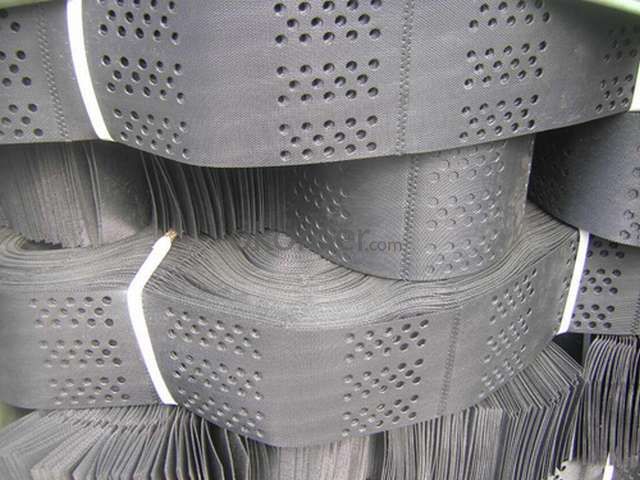
- Q: Are geocells resistant to puncture and damage?
- Yes, geocells are designed to be resistant to puncture and damage. They are typically made from high-density polyethylene (HDPE) material which provides excellent strength and durability. This makes them highly resistant to punctures and damage from external forces such as heavy loads, traffic, and environmental factors. Additionally, geocells are often reinforced with a cellular confinement system that enhances their resistance to puncture and damage, ensuring long-term performance and stability.
- Q: How do geocells reduce construction costs?
- Geocells reduce construction costs by providing a more cost-effective solution for soil stabilization and erosion control. They eliminate the need for traditional methods such as concrete or steel reinforcements, reducing material costs. Geocells also facilitate faster construction, requiring less labor and equipment, thereby lowering overall project expenses. Additionally, their long-lasting durability minimizes maintenance and repair costs in the long run.
- Q: Can geocells be used for retaining walls in high wind areas?
- Yes, geocells can be used for retaining walls in high wind areas. Geocells are often used in various applications, including retaining walls, due to their ability to provide stability and support to the soil. In high wind areas, geocells can help prevent soil erosion and maintain the integrity of the retaining wall, making them a suitable solution for such conditions.
- Q: Can geocells be used for dam construction?
- Yes, geocells can be used for dam construction. Geocells are three-dimensional cellular confinement systems made from high-density polyethylene (HDPE) materials that can provide stability and reinforcement to the soil when filled with aggregate. They can effectively control erosion, provide slope protection, and enhance the overall stability of the dam structure. Additionally, geocells can help with soil retention and prevent seepage, making them a suitable choice for dam construction.
- Q: Can geocells be used in coastal revetment projects?
- Yes, geocells can be used in coastal revetment projects. Geocells are a type of cellular confinement system that can provide erosion control and stability to coastal areas. They can be filled with various materials, such as soil or concrete, to create a reinforced structure that can withstand wave action and protect the coastline from erosion. Geocells are often used in coastal revetment projects due to their versatility, cost-effectiveness, and ability to adapt to different site conditions.
- Q: Are geocells suitable for use in flood control projects?
- Yes, geocells are suitable for use in flood control projects. Geocells are three-dimensional honeycomb-like structures made from high-strength materials, such as HDPE, which can provide soil stabilization and erosion control in flood-prone areas. They can be filled with different materials, such as gravel or soil, to create a strong and stable barrier against floodwaters. Geocells effectively distribute and dissipate the hydrostatic pressure caused by flooding, reducing the risk of soil erosion and damage to infrastructure. Additionally, they can be easily installed, cost-effective, and environmentally friendly, making them a practical solution for flood control projects.
- Q: How do geocells enhance the stability of railway embankments?
- Geocells enhance the stability of railway embankments by confining and reinforcing the soil fill. These three-dimensional honeycomb-like structures provide lateral support to the soil, preventing lateral spreading and improving load distribution. The geocells also increase the bearing capacity of the embankment, reducing settlement and potential deformation. Additionally, they help in preventing erosion and soil loss, ensuring long-term stability and durability of the railway embankment.
- Q: Do geocells require any additional reinforcement?
- Yes, geocells typically require additional reinforcement to enhance their structural integrity. This is achieved by filling the cells with aggregate materials such as soil or gravel, which provides additional stability and load-bearing capacity.
- Q: How do geocells enhance the stability of bridge approaches?
- Geocells enhance the stability of bridge approaches by providing a reinforced structure that distributes the load and prevents soil erosion. The interconnected cells confine the fill material, creating a stable foundation that can withstand heavy traffic and prevent settling or shifting of the soil. This improves the overall structural integrity of the bridge approach and ensures long-term stability.
- Q: What is the difference between geocells and geogrids?
- Geocells and geogrids are both geosynthetic materials used in construction and civil engineering projects, but they have distinct differences. Geocells are three-dimensional honeycomb-like structures made from high-density polyethylene (HDPE) or other similar materials. They are primarily used for soil stabilization, erosion control, and retaining wall construction. Geocells provide confinement and support to soil, preventing lateral movement and improving load distribution. The cells are filled with soil or aggregate, creating a stable and reinforced structure. On the other hand, geogrids are flat, grid-like sheets made from materials such as polyester, polypropylene, or fiberglass. They are primarily used for soil reinforcement, strengthening weak soils, and increasing the load-bearing capacity of the ground. Geogrids are placed within the soil or between different soil layers to enhance tensile strength and distribute loads more efficiently. In summary, geocells are three-dimensional structures used for soil confinement and stabilization, while geogrids are flat sheets used for soil reinforcement and increasing load-bearing capacity.
1. Manufacturer Overview
| Location | Taian City,Shandong Province,China |
| Year Established | 2003 |
| Annual Output Value | Above US$100 Million |
| Main Markets | Africa, North America, Eastern Europe, South Asia, Western Europe |
| Company Certifications | ISO9001;IS014001 Certificate |
2. Manufacturer Certificates
| a) Certification Name | |
| Range | |
| Reference | |
| Validity Period |
3. Manufacturer Capability
| a) Trade Capacity | |
| Nearest Port | Qingdao Port;Tianjing Port;Shanghai Port |
| Export Percentage | |
| No.of Employees in Trade Department | 21-30 People |
| Language Spoken: | English; Chinese; |
| b) Factory Information | |
| Factory Size: | 10,000-30,000 square meters |
| No. of Production Lines | Above 10 |
| Contract Manufacturing | Geotechnical Material (Geogrid,Fiberglass/Polyester Geogrid;Geocell;Geonet and Geomat;Plastic Safety Fence);Plastics products;Rubber products;Geotextile;Carpet;Compound geomembrane |
| Product Price Range | Average |
Send your message to us
Geocells Market HDPE Smooth Geocell Grass Paver with Vigrin Material and Good Price
- Loading Port:
- Qingdao
- Payment Terms:
- TT or L/C
- Min Order Qty:
- 5000 m²
- Supply Capability:
- 200000 m²/month
OKorder Service Pledge
OKorder Financial Service
Similar products
Hot products
Hot Searches
Related keywords
